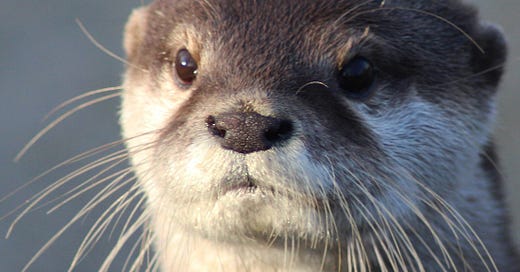Welcome back!
Last week we considered Autumnal equinox and the aspirational balance implied by equal periods of day and night. Before attempting to tap into that bitheistic yin-yang, know that Earth now has two moons!
So we’re working with an expanded cosmic pantheon here. Adjust your posture, make space in the circle, open them chakras a bit wider, then help us welcome asteroid 2024 PT5 to our oddball corner of the unfathomable horizon!
Stay awhile,
— Bird Club Studio
P.S. Otters First! Humans second.
UPDATES & ANNOUNCEMENTS

In honor of October Big Day—Saturday, 10/12—we’re gonna keep birding around Greenpoint after this week’s regularly scheduled walk! Details to come.
Don’t forget to check out Day Owl’s beautiful bags made entirely of PFAS-free, recycled, landfill-bound materials. Get 20% off your first order via code MBCTITMOUSE20.
Another reminder to check out NYC Luddite Club. They’re a group of teens who forego social media / smartphones and prioritize analog experiences. They set up a Prospect Park scavenger hunt that runs ‘til October 13. Destroy the machines! (Or at least destroy their momentary subjugation of your attention by doing something strange IRL!)
MICRO-SEASON SEP 30—OCT 6

Unlike the arbitrary quarters of labor hours made up by corporate humanoids, micro-seasons are straight from source, the great unity, the god-babe herself: Mama Natura. Current Japanese micro-season: "Insects hole up underground". As for McGolrick Park, New York City and perhaps even larger swathes of the eastern US, we notice—
Yellow-bellied Sapsuckers return · First of season Palm Warbler, Brown Creeper, White-throated Sparrow, Yellow-rumped Warbler, Eastern Towhee
BIRD REPORT
Who’d McGolrick Bird Club notice in situ this week?
Yellow-billed Cuckoo · Common Raven · White-throated Sparrow · Eastern Towhee · Eastern Phoebe · Eastern Wood-Pewee · Brown Creeper · Blackpoll Warbler · Bay-breasted Warbler · Belted Kingfisher · Palm Warbler · Swamp Sparrow · Yellow-bellied Sapsucker · Blue-headed Vireo · Rose-breasted Grosbeak · American Redstart · Northern Mockingbird · Common Yellowthroat · Ovenbird · Red-bellied Woodpecker · Canada Goose · Northern Parula · Chimney Swift · Black-throated Green Warbler · Black-and-white Warbler · Scarlet Tanager · Ruby-crowned Kinglet · Northern Flicker · Gray Catbird · American Kestrel · Downy Woodpecker · Red-eyed Vireo · Blue Jay · Northern Cardinal · Common Grackle · Black-throated Blue Warbler · Baltimore Oriole · American Crow · House Finch · Rock Pigeon · European Starling · American Robin · House Sparrow · Mourning Dove
Feel like you’re missing the migration gods’ missionaries? For the run of October, join us on Tuesday and Friday mornings, when birds are most active, starting around 7am. Just show up
Note that many of the above birds were seen wearing their “Female” plumage—what migrating birds of both sexes often sport in fall
MICRO-LESSON: EASTERN WOODPECKERS
One can barely walk NYC parks like McGolrick these days, senses turned up, without noticing a pretty ‘pecker.
Here are the four most common woodies of the eastern US:
Downy Woodpecker · North America’s most common woodpecker is also its smallest. Named for the white stripe that runs down their middle backs, these babes make squeaky-toy calls, including a descending trill that one clubber quipped goes downy-ward! Clever lot, y’all be.
Red-bellied Woodpecker · Red mohawks and studded leather jackets. These 1980’s punks exit McGolrick in late May before returning in October—like, right now! But their lewks, ch-ch-chs, rattles and churls can be noticed in bigger NYC parks year-round. Why red-bellied when all you see is an off-white tum-tum? Get up-close, like folks who named bird species did, to notice red-dusted fronts.
Yellow-bellied Sapsucker · Another woody—yes sapsuckers are woodies—who just arrived in McGolrick. Sapsuckers do in fact suck sap, along with any bugs surfing the stuff. Yellow-bellies have a line-headed + kinda dingy-bodied look, and can easily be ID’d by their bright white side-stripes. Females and young males look like the pictured breeding male but sans colors, and even dingier. Also pictured: sapsuckers leave neat rows of holes in the trees they tap.
Northern Flicker · Black pendant necklace, Yayoi Kusama approved spots, keer call, east of the rockies: yellow under-feathers, west of ‘em: pink, monkey call, lovers of ants—both for food and formic acid bathing, object of our pagan devotion. Reader, wherever you are in the US, go outside and notice a Northern Flicker RIGHT NOW.







